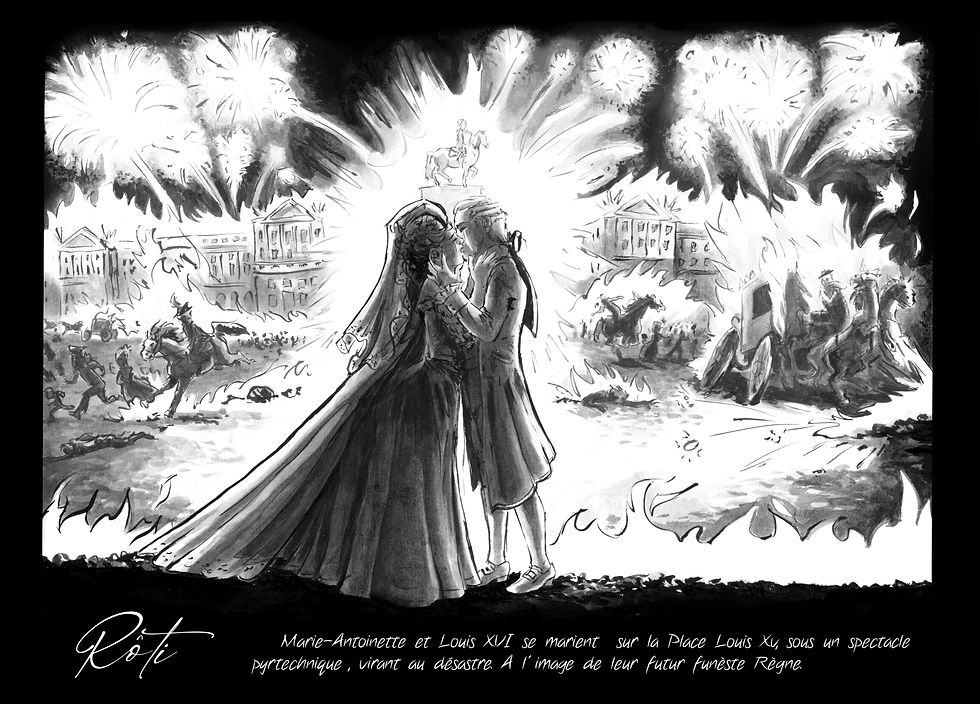painting, digital painting, ink, photoshop

1794: Robespierre is guillotined, his jaw hanging down and his eyes disillusioned in front of the enthusiastic people. Everything he accomplished will vanish: it is the end of the First Republic, of the Terror, of…. Revolution.


In mirror image, the revolutionaries fight against the royalist sans-culottes. The latter do not accept the king's death and do not want to participate in the war efforts. Robespierre wanting to save the Revolution will generate a genocide in Vendée

Danton makes accept the extraordinary criminal court to purify the prisons too full of anti-revolutionary. He does not realize that he has just struck down the Republic by establishing The Terror. The convention kills each other and sends all of its great politicians to the guillotine

After a long trial based on no solid accusations, the people are offered the head of their former sovereign Queen Marie Antoinette, much to their delight


In the early days of the young Republic, anarchy reigned in the streets. The people do their own justice to the nobles and royalists in the prisons with beheadings and torture

Cut off his head: January 21, 1793, Robespierre's spell comes true: Louis XVI is guillotined on the Place de la Révolution after a very long heated trial. It is the fall of the Monarchy.

While the French volunteer soldiers win the Battle of Valmy against the Prussian armies, the royal family is dragged through the mud. They end up being locked in the temple prison, then they will be separated with the Queen sent to La Conciergerie prison.

In this stormy context, Versailles as well as the crown treasure in the storage room were looted. Le Régent, le Sancy, des Mazarins and the famous Bleu de la Toison d'or by Louis xiv disappeared.


1791: the Royal family tries to regain Austria to escape the Revolution. But they are discovered in Varennes, then repatriated to Paris. This attempt to flee the king breaks the last bond of trust with his people


Forced to accept, the royal family returned to Paris. The King, locked in the Louvre, has never felt so observed and mocked by his former subjects who have become citizens

Despite previous events, the Third Estate is still hungry and angry. They went for the first time directly to the Palace of Versailles to demand the King's return to Paris.

By signing this declaration, the King accepts the abolition of privileges, which leads to the destruction of the 3 orders. The clergy and the nobility turned against him. But he can't back down any longer.

Following the events under pressure from the National Assembly, the King is forced to sign the Declaration of Human and Citizen Rights. He becomes the first King under a Constitutional Monarchy, and the weakest of his Dynasty


the fortress of the Bastille is the priosn and symbol of royal absolutism. The people unirted under a new banner wrest control and power form the guards.


The revolt of the Parisians turns violent. The first victim is the Governor of the Bastile de Launay

the events of spring 1789, with he conveing of the Estate Geenral but also so many taking up arms around the countryside.

1789 – the harvests are bad. The reserves exhausted. A great famine in the land as the peasants are fatigued.

This event showing event of June 1789, with the Estates General meeting and the King and Queen preoccupied with their dying son. The figure of Necker also lurking in this image.

To annoy the English, Louis XvI agrees to send the young Marquis de Lafayette and to finance the campaign of independence of America

In Paris, the people starve and have little to eat.

At Versailes the King and Queen dine in opulence and lack for nothing. So, they are most comfortable.

As held by tradition, the boy Robespierre had the great honor to read to the new Royal Couple the “Compliments to Royalty” but neither Louis or Marie Antoinette would leave their coach. The boy cried and vowed some day he would take his vengeance on these arrogant uncaring monarchs.

Marie Antoinette and Louis XVI wedding. With fireworks aiming for disaster … A sad picture of their deadly fate.

For a century, the High Nobility has enjoyed their privileges and a peaceful life at the Court of Versailles , far from the tumult

1788 - The clergy and the nobility make toast of the third estate


